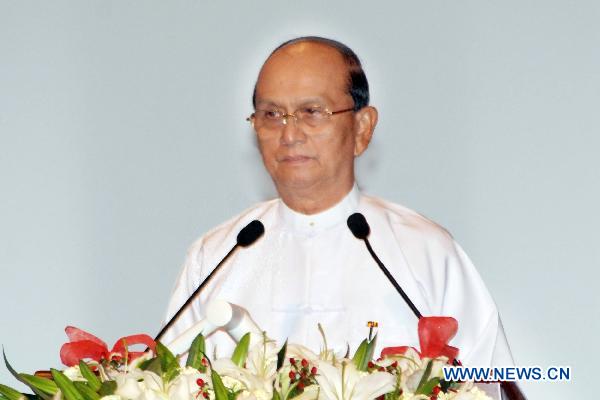Nay Pyi Taw, Burma (Xinhua): Burmese elected President U Thein Sein and two vice presidents, U Tin Aung Myint Oo and Dr. Sai Mauk Kham, were sworn in on Wednesday in the new capital Nay Pyi Taw in the presence of members of parliament.The swearing-in ceremony took place along with the dissolution of the ruling junta State Peace and Development Council (SPDC) and the transfer of power to the new government, SPDC Chairman Senior- General Than Shwe announced on state TV.

U Thein Sein at a ceremony in Nay Pyi Taw, Myanmar. Myanmar's elected president U Thein Sein and two vice presidents, U Tin Aung Myint Oo and Dr. Sai Mauk Kham, were sworn in on Wednesday in the new capital Nay Pyi Taw in the presence of members of parliament. (Xinhua /Zhang Yunfei)
Meanwhile, General Min Aung Hlaing, former chief of Bureau of Special Operation No. 2, took over as new Commander-in-Chief of Burmese Defense Services, replacing Than Shwe.
President U Thein Sein unveiled cabinet lineup comprising 30 ministers, including defense minister Major-General Hla Min, home minister Lieutenant-General Ko Ko, border affairs minister and industrial development minister Major-General Thein Htay, and foreign minister U Wunna Maung Lwin.
These union-level organs established include the 21-member financial commission, chaired by president U Thein Sein, 7-member union supreme court, headed by U Tun Tun Oo, 9-member union constitutional tribunal, chaired by U Thein Soe, 8-member union election commission, led by U Tin Aye, 6-member union civil service board, led by U Kyaw Thu and 10-member Nay Pyi Taw Council, led by U Thein Nyunt.
With Nay Pyi Taw designated as the country’s capital standing as a union region directly under president’s administration, the country’s inalienable administrative regions are demarcated as seven regions and seven states of national races as well as five self-administered zones of ethnic minorities and one self- administered division of another minority.
U Thein Sein also named 14 chief ministers for 14 respective regions and states with nine ministers each to run nine ministries or combined ministries.
These nine region or state ministries or combined ministries cover security and border affairs, economics, agriculture and forestry, development affairs, transport, mines, industry, education and health, social and religious affairs and culture, administration, finance and revenue, electric power, communications, construction and information.
Moreover, U Thein Sein also appointed 14 region- or state-level organs such as auditors-general, attorneys-general, judges, national affairs ministers, chiefs of local administration of self- administerd zones or divisions.
In Burmese presidential election on Feb. 4 held in the course of parliamentary sessions, U Thein Sein won the presidency, while U Tin Aung Myint Oo and Dr. Sai Mauk Kham were elected as the vice presidents.
Thein Sein was formerly prime minister, while Tin Aung Myint Oo was first secretary of the previous ruling State Peace and Development Council and Sai Mauk Kham was an ethnic doctor.
All of the three represent the Union Solidarity and Development Party (USDP), led by Thein Sein.
The terms of office of the president and the vice presidents are five years, according to the new state constitution-2008.
According to the new state constitution, the name of Burma is the Republic of the Union of Myanmar. The president is the head of state and the government.
The Union Parliament comprises House of Representatives (Lower House) and House of Nationalities (Upper House). The legislative power is shared by union parliament, region or state parliament as well as self-administered zones’ or divisions’.
Under the constitution, politically, it pursues a multi-party system and the military will participate in the leading role in the country’s national politics.
Economically, it adopts a market-oriented economic system, while in foreign relations, Burma practices an independent, active and non-aligned foreign policy and maintain friendly relations with foreign nations, upholding the principles of peaceful coexistence among nations.






















